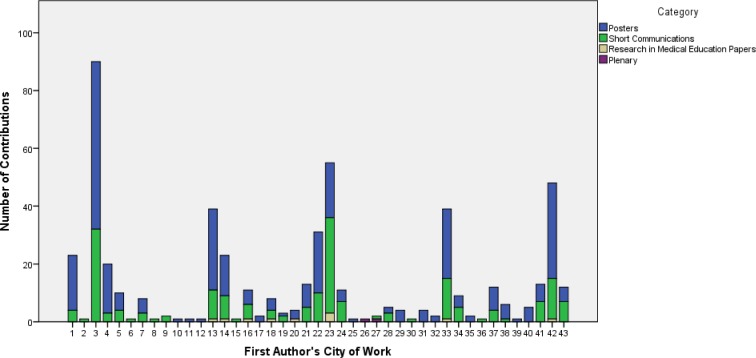Abstract
Objectives: Medical education is gaining in significance internationally. A growing interest in the field has been observed in German-speaking countries (Austria, Germany, Switzerland) since the early 2000s. This interest is not, however, reflected in an increase in the number of publications on medical education of German-speaking authors in international professional journals. The following investigation examines the potential use of active participant numbers of German-speaking researchers at AMEE conferences as a means of measuring said development.
Methods: The AMEE conference proceedings from the categories poster presentations, short communications, research papers and plenary presentations from the years 2005-2013 were examined for evidence of Austrian, German and Swiss participation. The abstracts were subsequently analysed in terms of content and categorised according to study design, methodology, object of study, and research topic.
Results: Of the 9,446 analysed abstracts, 549 contributions show at least one first, last or co-author from Austria, Germany or Switzerland. The absolute number of contributions per conference varied between 44 in 2010 and 77 in 2013. The percentage fluctuated between 10% in 2005 and 4.1% in 2010. From the year 2010 onwards, however, participation increased continually. The research was predominantly descriptive (62.7%). Studies on fundamental questions of teaching and learning (clarification studies) were less frequent (4.0%). For the most part, quantitative methods (51.9%) were implemented in addressing subjects such as learning and teaching methods (33%), evaluation and assessment (22.4%) or curriculum development (14.4%). The study population was usually comprised of students (52.5%).
Conclusions: The number of contributions from Austria, Germany and Switzerland peak at the beginning and at the end of the evaluated period of time. A continual increase in active participation since 2005 was not observed. These observations do not reflect the actual increase of interest in medical education research in German-speaking countries.
Keywords: medical education, AMEE, conferences and congresses, Austria, Germany, Switzerland, research design
Zusammenfassung
Zielsetzung: International gewinnt medizinische Ausbildungsforschung an Bedeutung. Seit Anfang der 2000er ist auch in deutschsprachigen Ländern (D-A-CH) ein steigendes Interesse zu beobachten. In einer kontinuierlichen Steigerung der Publikationszahlen deutscher Autoren in internationalen Fachzeitschriften zum Thema „medizinische Ausbildung“ schlug sich das bisher jedoch nicht nieder. Die vorliegende Arbeit untersucht, ob sich jene Entwicklungen aus der aktiven Teilnahme deutschsprachiger Forscher an den Konferenzen der AMEE ablesen lassen.
Methoden: Die Tagungsbände der AMEE-Kongresse von 2005-2013 der Kategorien „Postervorträge“, „Short Communications“, „Research Papers“ und „Plenarvorträge“ wurden auf Beteiligung aus D-A-CH hin untersucht. Im Anschluss wurden die Abstracts einer inhaltlichen Analyse unterzogen und nach Studiendesign, Methodik, Untersuchungsgegenstand und Forschungsthema kategorisiert.
Ergebnisse: Von 9446 analysierten Abstracts weisen 549 Beiträge mindestens einen Erst-/Co- oder Letztautor aus D-A-CH auf. Die absolute Zahl der Beiträge pro Kongress schwankt zwischen 44 im Jahr 2010 und 77 im Jahr 2013. Der prozentuale Anteil schwankt zwischen 10,0% in 2005 und 4,1% im Jahr 2010. Seit 2010 stieg die Beteiligung jedoch kontinuierlich an. Die Arbeiten sind zumeist deskriptiver Art (62,7%). Studien zu grundlegenden Fragen des Lehrens und Lernens (clarification studies) sind eher selten (4,0%). Angewandt wurden meist quantitative Methoden (51,9%), um Fragestellungen zu Themen wie Lehr- und Lernmethoden (33,0%), Evaluation und Assessment (22,4%) oder Curriculumsentwicklung (14,4%) zu untersuchen. Untersuchungsgegenstand sind meist Studierende (52,5%).
Schlussfolgerung: Die Beitragszahlen aus D-A-CH weisen zu Beginn und am Ende des Untersuchungszeitraums ein Maximum auf. Ein kontinuierlicher Anstieg der aktiven Beteiligung seit 2005 ist nicht zu beobachten. Dieser Umstand spiegelt nicht das steigende Interesse an der medizinischen Ausbildungsforschung in den deutschsprachigen Ländern wieder.
Introduction
At the beginning of the new millennium, medical education research was only sporadically established and professionalised in Germany [14]. The revision of medical licensure regulation in 2002 resulted in fundamental changes in the field of medical education in Germany. Practical relevance and the development of social skills were granted a more significant status [5]. This led to essential curricula reforms and to the examination of issues of medical pedagogy in many medical faculties in Germany. Initiated by medical education reforms in countries such as the United States and the Netherlands, for example, a simultaneous reform of medical courses of study and their curricula occurred in Switzerland [20]. Similarly, the accreditation act of 1999/2000 and the university act of 2002 effectuated a range of structural innovations in Austria [3]. The increase in interest in medical education research in Germany that Rost [18] had observed in 2005 found support in the rapid increase in the number of visitors accessing articles from the GMS – German Journal for Medical Education – observed by Eisnach et al [8]. The establishment of a German-language masters of medical education (MME) course of studies in 2004 [9], [13] also emphasises this tendency. The following work addresses the question of whether this positive development is reflected in the involvement of German-speaking authors in the conferences of the Association for Medical Education in Europe (AMEE).
The Association for Medical Education in Europe (AMEE) was founded in 1972 in Copenhagen and has offered instructors in the field of medicine from different countries the opportunity for information exchange and further education [22]. In addition to annually held conferences, the AMEE publishes the Medical Teacher professional journal as well as the AMEE Education Guide and initiates various courses and projects worldwide on subjects of medical education.
Eisnach et al [8]. have already examined the possible reflection of the above-mentioned developments in German medical education research in an increase in German-speaking authors’ publications in the five leading international journals of medical education research. A rather sparse representation of German authors in the examined journals (1.4% of the total of articles published), however, was evidenced [8]. Additionally, fluctuations were shown in the number of publications over time [8]. Because the publication of studies and scientific findings in journals only represents one aspect of international research exchange, the following research examines German-speaking participation at AMEE conferences between the years 2005 and 2013.
References offer divisive opinions on the quality of methods applied in medical education research. It was established that research was often based on inadequate scientific study designs [6], [12], [15], [23]. On the other hand, Baernstein el al. [2] show that the applied methods have continually improved since the 1970s. In order to advance medical education research and to develop new research approaches, fundamental research (clarification studies [7]) is necessary in this currently underappreciated field [19]. By means of a content analysis of the abstracts from the above-mentioned time frame, the following research endeavours to show which methodological approaches prevail in AMEE contributions from German-speaking participants. In like manner, research subjects and objects of study were examined for their comparability to those of international publications.
Accordingly, the present work offers answers to the following questions:
How many contributions (posters, short communications, research in medical papers, plenaries) from German-speaking authors were presented at AMEE conferences between 2005 and 2013? Can a trend be inferred from this data?
What types of studies were addressed and what methods were employed?
Which subjects were examined in the studies and what were the objects of investigation?
Methods
For the examination of the above-mentioned issues, the proceedings from the AMEE conferences from 2005 to 2013 were analysed for Austrian, German or Swiss authorship, and a data bank was created. All contributions were considered in which at least one German-speaking first, last or co-author (work location: Austria, Germany or Switzerland) was involved. Only the contributions from the following four superordinate categories were taken into account:
Poster Presentations: including ePosters, since these are presented in digital form at the conferences. Web posters, on the contrary, were not presented at the conferences and were therefore not considered in the present analysis. Poster presentations take place in thematically grouped sessions and usually last two to three minutes with ensuing questions and discussion.
Short Communications: Authors typically introduce their work in ten-minute presentations, with an ensuing five-minute question-and-answer session.
Research in Medical Education Papers: After research presentations of typically fifteen minutes in length, a five-minute period is available for questions and discussion.
Plenaries: Large-audience plenary lectures, followed by a question and answer session.
Other events and contributions, such as workshops taking place in the framework of the conferences, were not included in the analysis. Thus, 9446 contributions were filtered, resulting in 549 abstracts with German-speaker participation which were then analysed in the further evaluation process (see Figure 1 (Fig. 1)).
Figure 1. Flowchart of the process of selection from the AMEE conference proceedings from the years 2005-2013.
In the databank, the names and the places of work of the first, last and co-authors, as well as the country of work of the last author were assigned to each contribution. Because the author’s respective faculty was not always evident in the conference proceedings and since some of the contributions originated from cities without any medical faculty, only the contribution city of origin and no individual faculties were used. In a next step, all 549 contributions were analysed for content type and categorised according to: type of study, methodology, object of study and research topic. The subcategories in object of study and research topic were drafted by three of the present work’s authors. The categorisation was undertaken by one person, with clarification of ambiguous attribution in discussion with the other authors. The subcategories were defined as follows:
Type of study
According to Cook et al. [7], in terms of study design, works of medical education research can be classed in the following three categories: description studies, justification studies and clarification studies. Description studies are of a purely factual nature, simply describing the interventions or processes implemented. They may present result data (e.g. evaluation results), but these are not absolutely necessary. Justification studies range in the next higher level of investigation. The intention here is to establish the value of an intervention, for example by opting for a randomised control group design. Clarification studies are necessary in order to detect basic mechanisms and correlations in the field of medical education. The questions of why or in what way an intervention functions are examined here with the aid of explanatory models [7].
Methods
Provided that the type of methodology applied was evident in the abstract, each contribution was categorised according to its use of quantitative, qualitative or mixed methods [4].
Object of study
In order to designate the objects of study of the contributions, the following subcategories were defined: students/undergraduates, physicians/postgraduates, organisation/institution, documents, other. The students/undergraduates subcategory is not limited to medical students, but also encompasses nursing students and other trainees, for instance. Similarly, the subcategory physicians/postgraduates encompasses contributions in which the object of study was not chiefly physicians, but also carers and non-clinical medical practitioners, for example. Projects in which the object of study was identified as an organisation/institution did not deal directly with trainers or trainees, but examined a faculty or a department as a whole, for instance. A document analysis, by contrast, examines data which are already available as a written source of information. The subcategory other comprises all studies in which the object of study could not be assigned to the former subcategories.
Research topic
The superordinate research topics of the projects were divided into the following subcategories: curriculum development, teaching/learning methods, skills and learning objectives, implementation and maintenance, evaluation and assessment, other. All studies involving curricular changes were assigned to the subcategory curriculum development. If, on the contrary, teaching methods were elucidated in detail (e.g., e-learning, simulations, etc.) and information was not restricted to the simple description of a curriculum’s extension by an event, the contribution was assigned to the subcategory teaching/learning methods. This subcategory also encompasses studies analysing learning behaviour. Contributions addressing specific skills or learning objectives were placed in the subcategory skills and learning objectives. The subcategory implementation and maintenance comprises studies examining faculty development as a whole. Presentations dealing with innovation management or medical didactic training fall into this final category. All contributions dealing with testing methods and test evaluations in the broadest sense, as well as studies concerning the evaluation of existing structures were assigned to the subcategory evaluation and assessment. In the categorisation of research topics, the subcategory other was also established, under which all unassignable topics were subsumed.
In order to ascertain the percentage share of German-speaking authors in the total number of contributions, the total number of talks held was determined using the conference proceedings from the designated sample period. To guarantee comparability, this section also only summarises contributions from the four categories poster, short communication, research paper, and plenary.
The frequency analysis of the data and the illustration of the results were effected using IBM SPSS Statistics 21.
Results
Number and type of contributions by German-speaking authors
A total of 549 projects by German-speaking authors were presented at AMEE conferences between the years 2005 and 2013. The number of contributions per conference fluctuated between 44 in the year 2010 and 77 in the year 2013. In numbers, this greatest representation of German-speaking authors to date (see Figure 2 (Fig. 2)) The percentage of German-speaking contributions from the overall total number of presentations fluctuates between 4.1% in 2010 and 10.0% in 2005 (see Figure 3 (Fig. 3)). Table 1 (Tab. 1) offers an overview of this finding. Collectively, 5.8% of all contributions from the evaluation period are by German-speaking authors.
Figure 2. Number of contributions by German-speaking authors per conference year.
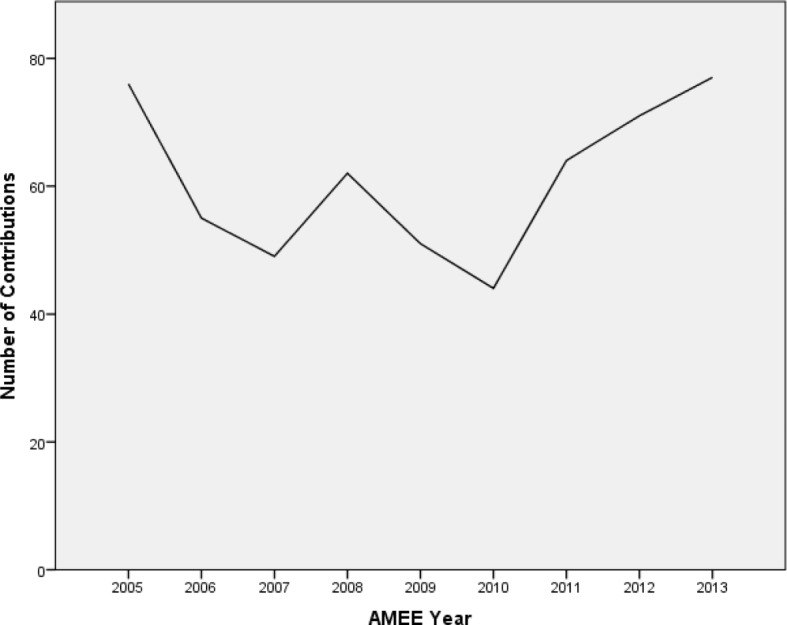
Figure 3. Percentage of German-speaker contributions relative to the total number of contributions.
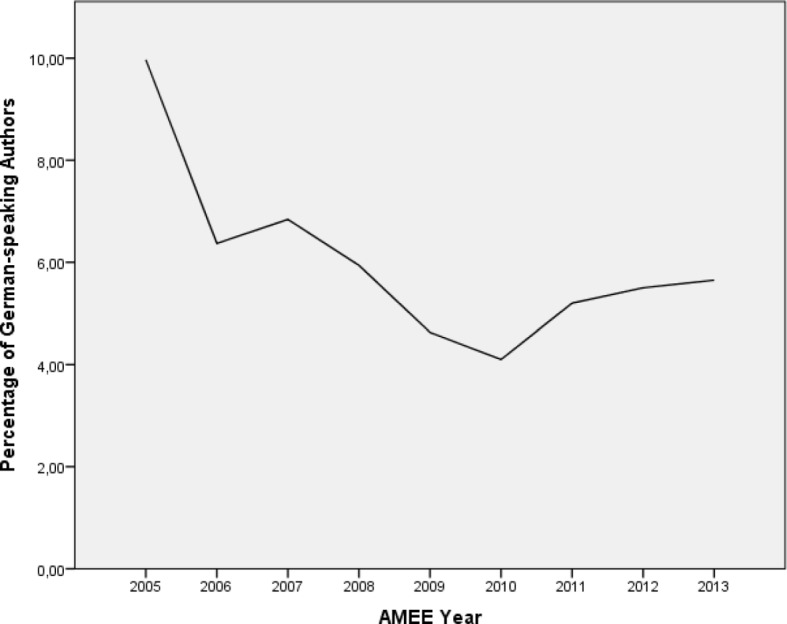
Table 1. Overview – contributions of German-speaking authors at AMEE conferences from 2005 to 2013.
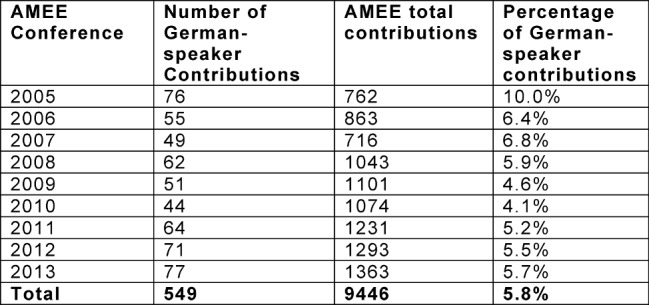
Table 2 (Tab. 2) offers an overview of type and origin of all analysed items. The majority of contributions from the evaluation period by German-speaking researchers consists of poster presentations (60.3%). The next-largest percentage consists of short communications. Research paper and plenary presentations represent only a low percentage. The second segment of table 2 (Tab. 2) illustrates the countries of origin of all analysed items. To this end, all abstracts with at least one German-speaking first, last or co-author were listed in respect to the last author’s country of work. This classification shows that the majority of articles come from Germany (444 total contributions, 80.9%).
Table 2. Type and origin of German-speaker contributions at AMEE conferences from 2005 to 2013.
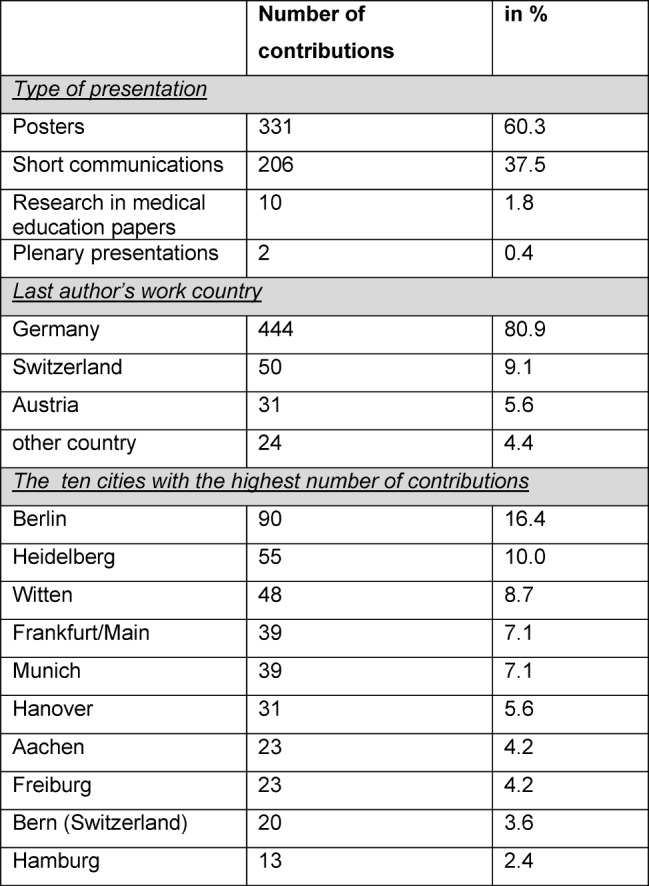
The publication activity at AMEE conferences shows that most of the German-speaker contributions come from Berlin (see the third segment of table 2 (Tab. 2)). Following at some distance were Heidelberg and Witten. Frankfurt/Main and Munich share fourth place. The respective work location of the first author was used in this frequency analysis. Figure 4 (Fig. 4) shows the number of contributions of all participating German-speaking cities during the stated evaluation period, broken down according to presentation type.
Figure 4. Number of contributions from participating German-speaking cities at AMEE conferences from 2005 to 2013.
Methodological and thematic categorisation of contributions
The contributions by German-speaking authors at AMEE conferences in the stated evaluation period are predominately descriptive studies (62.7%, see table 3 (Tab. 3) ). Justification studies make up one-third of all contributions (33.3%), while clarification studies represent the lowest percentage at a mere 4.0%.
Table 3. Categorisation of German-speaker contributions at AMEE conferences from 2005 to 2013 based on various criteria (n=549).

The applied methods are usually of quantitative nature (51.9%). The data of a relatively large number of studies, however, were measured by means of qualitative methods (38.6%). For the most part, students were examined (52.5%). Other favoured objects of study were various organisations and institutions (19%), as well as physicians and individuals with completed qualification (15.7%). Core themes in the contributions examined are teaching and learning methods (33.0%), as well as evaluation and assessment (22.4%). Likewise, many of the contributions deal with curriculum development (14.4%).
Discussion
AMEE contributions from German-speaking authors
The results of the present frequency analysis show a fluctuating representation of German-speaking educational researchers at AMEE conferences between the years 2005 and 2013. The number of German-speaker contributions was very high at the beginning of the evaluated period, decreasing in 2010 to a minimum, and then rising again to a new peak in 2013. Considering the percentage of contributions by German-speaking researchers in the total of all presentations, it is apparent that the share of German-speakers in recent years was never as great as in the years 2005 to 2007. From 2010 onwards, however, both the absolute numbers and the relative value show a continual increase in German-speaking educational researcher participation at AMEE conferences.
Changes in the regulatory framework for university education in Austria, Germany and Switzerland [3], [5], [20]. at the beginning of the millennium could explain the relatively high number of German-speaker contributions at the beginning of the evaluated period. Curricular innovations were referred to and examined, and comparisons of students from the terminating and new, reformed curricula conducted. The total of all studies presented at the AMEE at the beginning of the evaluated period was, however, significantly lower than at the end, giving more weight in the frequency analysis to contributions by German-speaking authors.
Eisnach et al. showed that 1.4% of the published articles concerning medical education research in the most important international English-language journals were authored by German-speakers (evaluated period 2004 to 2009 [8]). The active participation of German-speaking researchers at the annual AMEE conferences was significantly higher (4.1% to 10%). It must be pointed out, however, that contributions from Austria and Switzerland were not taken into account by Eisnach et al. Another possible reason for this discrepancy could be the fact that primarily justification and clarification studies were published in the international journals (70% of the journal articles by German- speaking authors [8]). In contrast, the present research shows that German-speaking researchers at AMEE conferences predominately present descriptive studies (63%) as poster presentations (60%) that are rarely then published as journal articles.
There were great differences between individual (faculty) cities with regard to the publication of medical didactic research at the AMEE. While several cities were frequently represented, others appeared only occasionally. Eisnach et al. also produced similar results [8]. This may also be a reflection of varying degrees of development and significance of medical didactics at the different sites. The lack of medical didactics experts in Germany [11] may also be a reason for the slow acknowledgement of the importance of educational research there.
Methodological and thematic categorisation
Eisnach et al. could only partially refute the research results of various authors [6], [12], [15], [23] that assert that investigations of medical education were based on deficient scientific approaches and study designs [8]. Baernstein et al. [2] could also show that the quality of the applied methods in this discipline has risen internationally since the 1970s. Unfortunately, medical education research, rooted in the field of medicine, still tends to work quantitatively, ascribing less value to qualitative research [7], [21]. Rotgans [19] confirms that medical education research overvalues effectiveness analysis and seldom attempts to come up with new research approaches or conduct fundamental research. Qualitative methods are necessary, however, in order to implement such clarification studies. Only 11.5% of the German articles in international journals draw on such methods [8]. Even so, almost 40% of German-speaker AMEE contributions show the use of qualitative methods, as evidenced in the present research.
Rotgans [19] examined the content of international abstracts from six of the most important journals of medical education research published in between 1988 and 2010 and showed that assessment, skills training, practical training and teaching methods were the four most researched topics. The present research establishes that German-speaking AMEE contributions also attribute the greatest significance to the areas of teaching/learning methods and assessment. Teaching and learning methods, curriculum development and assessment are the most prominent topics in journal articles by German-speaking authors [8]. The most frequent objects of study in the AMEE contributions and those of the journal articles by German authors are also largely congruent. In both cases, students and qualified professionals were the most important object of study. Organisation/institution is the only object of study to appear frequently in the studies presented at AMEE conferences. This is possibly because a conference lends itself particularly to the presentation of an organisation.
Limitations of the present study
Because the present study is restricted to AMEE conference contributions, its use in drawing inferences regarding the general evolution of medical education research in German-speaking countries is limited. Particularly because a relatively short time frame (nine conferences) was investigated. In order to arrive at more specific assertions, proceedings from further conferences must be examined. Furthermore, the share of studies on medical education presented at medical specialist conferences and at educational or psychologist conferences remains unclear. Another aspect to consider is the growing significance of educational research not only in Germany but also internationally [1], [2], [10], [16]. One indication of this is the total number of contributions (poster presentations, short communications, research papers and plenary presentations) at AMEE conferences, showing a continual rise from 762 since the year 2005 to last year’s 1,363, as shown in the present study. Increasing international interest in medical education research (for example, in Asia, South America or Africa [1], [10], [16]) could also result in growing competition for German-speaking countries.
A comparison of the participation percentage of other countries at AMEE conferences would have provided an interesting approach to better estimate the role of German-speaking medical education researchers internationally. This, however, would have gone beyond the scope of the present work.
Conclusion
Overall, it is clear that an increase in the significance of medical didactics in German-speaking Europe cannot be corroborated by Eisnach et al. or by the present research using frequency analyses of international publications. The period evaluated by Eisnach et al., however, ends in 2009. The present research, on the other hand, documents a continual increase in the representation of German-speaking authors at AMEE conferences since the year 2010. Further investigations must be conducted to establish whether or not this development will continue.
Data
Data for this article are available from the Dryad Digital Repository: http://dx.doi.org/10.5061/dryad.9b56t [17].
Competing interests
The authors declare that they have no competing interests.
References
- 1.Amin Z, Hoon Eng K, Gwee M, Dow Rhoon K, Chay Hoon T. Medical education in Southeast Asia: emerging issues, challenges and opportunities. Med Educ. 2005;39(8):829–832. doi: 10.1111/j.1365-2929.2005.02229.x. Available from: http://dx.doi.org/10.1111/j.1365-2929.2005.02229.x. [DOI] [PubMed] [Google Scholar]
- 2.Baernstein A, Liss HK, Carney PA, Elmore JG. Trends in study methods used in undergraduate medical education research, 1969-2007. JAMA. 2007;298(9):1038–1045. doi: 10.1001/jama.298.9.1038. Available from: http://dx.doi.org/10.1001/jama.298.9.1038. [DOI] [PMC free article] [PubMed] [Google Scholar]
- 3.Bauer B. Die Neuorganisation des österreichischen Universitätswesens: die neuen staatlichen und privaten Medizinuniversitäten und ihre Bibliotheken. Med Bibl Inf. 2005;5(1):51–54. Available from: http://www.agmb.de/mbi/2005_1/bauer2.pdf. [Google Scholar]
- 4.Bortz J, Döring N. Forschungsmethoden und Evaluation: Für Human-und Sozialwissenschaftler. 4. Aufl. Berlin, Heidelberg, New York: Springer; 2006. Available from: http://dx.doi.org/10.1007/978-3-540-33306-7. [DOI] [Google Scholar]
- 5.Clade H. Reform des Medizinstudiums. Ein langer Weg. Dtsch Ärztebl. 2002;99(18):1189. [Google Scholar]
- 6.Cook DA, Beckman TJ, Bordage G. A systematic review of titles and abstracts of experimental studies in medical education: many informative elements missing. Med Educ. 2007;41(11):1074–1081. doi: 10.1111/j.1365-2923.2007.02861.x. Available from: http://dx.doi.org/10.1111/j.1365-2923.2007.02861.x. [DOI] [PubMed] [Google Scholar]
- 7.Cook DA, Bordage G, Schmidt HG. Description, justification and clarification: a framework for classifying the purposes of research in medical education. Med Educ. 2008;42(2):128–133. doi: 10.1111/j.1365-2923.2007.02974.x. Available from: http://dx.doi.org/10.1111/j.1365-2923.2007.02974.x. [DOI] [PubMed] [Google Scholar]
- 8.Eisnach K, Jünger J, Fischer MR. Entwicklung der deutschen medizinischen Ausbildungsforschung im internationalen Kontext: Eine Artikelanalyse. Jahrestagung der Gesellschaft für Medizinische Ausbildung (GMA); 23.-25.09.2010; Bochum. Düsseldorf: German Medical Science GMS Publishing House; 2010. p. Doc10gma83. Available from: http://dx.doi.org/10.3205/10gma083. [DOI] [Google Scholar]
- 9.Fischer MR, Jünger J, Duelli R, Putz R, Resch F. Konzeption und Erfahrungen mit dem deutschen Master of Medical Education (MME)-Studiengang des medizinischen Fakultätentages (MFT) an der Medizinischen Fakultät Heidelberg. GMS Z Med Ausbild. 2006;23(2):Doc26. Available from: http://www.egms.de/static/de/journals/zma/2006-23/zma000245.shtml. [Google Scholar]
- 10.Greysen SR, Dovlo D, Olapade-Olaopa EO, Jacobs M, Sewankambo N, Mullan F. Medical education in sub-Saharan Africa: a literature review. Med Educ. 2011;45(10):973–986. doi: 10.1111/j.1365-2923.2011.04039.x. Available from: http://dx.doi.org/10.1111/j.1365-2923.2011.04039.x. [DOI] [PubMed] [Google Scholar]
- 11.Hahn EG. Medizinische Ausbildungsforschung im Deutschen Sprachraum: Quantité Négligeable? GMS Z Med Ausbild. 2005;22(2):Doc28. Available from: http://www.egms.de/static/de/journals/zma/2005-22/zma000028.shtml. [Google Scholar]
- 12.Hutchinson L. Evaluating and researching the effectiveness of educational interventions. Br Med J. 1999;318(7193):1267–1269. doi: 10.1136/bmj.318.7193.1267. Available from: http://dx.doi.org/10.1136/bmj.318.7193.1267. [DOI] [PMC free article] [PubMed] [Google Scholar]
- 13.Jünger J, Fischer MR, Duelli R, Putz R, Resch F. Konzeption, Implementierung und Evaluation eines interfakultären Master of Medical Education Programms. Z Evid Fortbild Qual Gesundheitswes. 2008;102(10):620–627. doi: 10.1016/j.zefq.2008.11.017. Available from: http://dx.doi.org/10.1016/j.zefq.2008.11.017. [DOI] [PubMed] [Google Scholar]
- 14.Niethammer D. Empfehlungen zu forschungs- und lernförderlichen Strukturen in der Universitätsmedizin. Berlin: Wissenschaftsrat; 2004. [Google Scholar]
- 15.Prideaux D, Bligh J. Research in medical education: asking the right questions. Med Educ. 2002;36(12):1114–1115. doi: 10.1046/j.1365-2923.2002.01411.x. Available from: http://dx.doi.org/10.1046/j.1365-2923.2002.01411.x. [DOI] [PubMed] [Google Scholar]
- 16.Pulido M, Pablo A, Cravioto A, Pereda A, Rondón R, Pereira G. Changes, trends and challenges of medical education in Latin America. Med Teach. 2006;28(1):24–29. doi: 10.1080/01421590500441869. Available from: http://dx.doi.org/10.1080/01421590500441869. [DOI] [PubMed] [Google Scholar]
- 17.Raes P, Bauer D, Schöppe F, Fischer MR. Data from: The active participation of German-speaking countries in conferences of the Association for Medical Education in Europe (AMEE) between 2005 and 2013: a reflection of the development of medical education research? Dryad Digital Repository; 2014. Available from: http://dx.doi.org/10.5061/dryad.9b56t. [DOI] [PMC free article] [PubMed] [Google Scholar]
- 18.Rost DH. Interpretation und Bewertung pädagogisch-psychologischer Studien. Weinheim/Basel: Beltz; 2005. [Google Scholar]
- 19.Rotgans J. The themes, institutions, and people of medical education research 1988-2010: content analysis of abstracts from six journals. Adv Health Sci Educ. 2011;17(4):515–527. doi: 10.1007/s10459-011-9328-x. Available from: http://dx.doi.org/10.1007/s10459-011-9328-x. [DOI] [PubMed] [Google Scholar]
- 20.Schirlo C. Die Reform des Studiengangs Medizin – Leitkonzepte und spezifische Aspekte der Modularisierung. Beitr Lehrerbild. 2006;24(3):388–396. [Google Scholar]
- 21.Whitcomb ME. The medical school's faculty is its most important asset. Acad Med. 2003;78(2):11711–11718. doi: 10.1097/00001888-200302000-00001. Available from: http://dx.doi.org/10.1097/00001888-200302000-00001. [DOI] [PubMed] [Google Scholar]
- 22.Wojtczak A. The Association for Medical Education in Europe (AMEE): its conception and development. Dundee: AMEE; 2010. Available from: http://www.amee.org/getattachment/what-is-amee/History_AMEE_CD_AUG2013.pdf. [Google Scholar]
- 23.Wolf FM. Methodological quality, evidence, and Research in Medical Education (RIME) Acad Med. 2004;79(10):68–69. doi: 10.1097/00001888-200410001-00021. Available from: http://dx.doi.org/10.1097/00001888-200410001-00021. [DOI] [PubMed] [Google Scholar]




